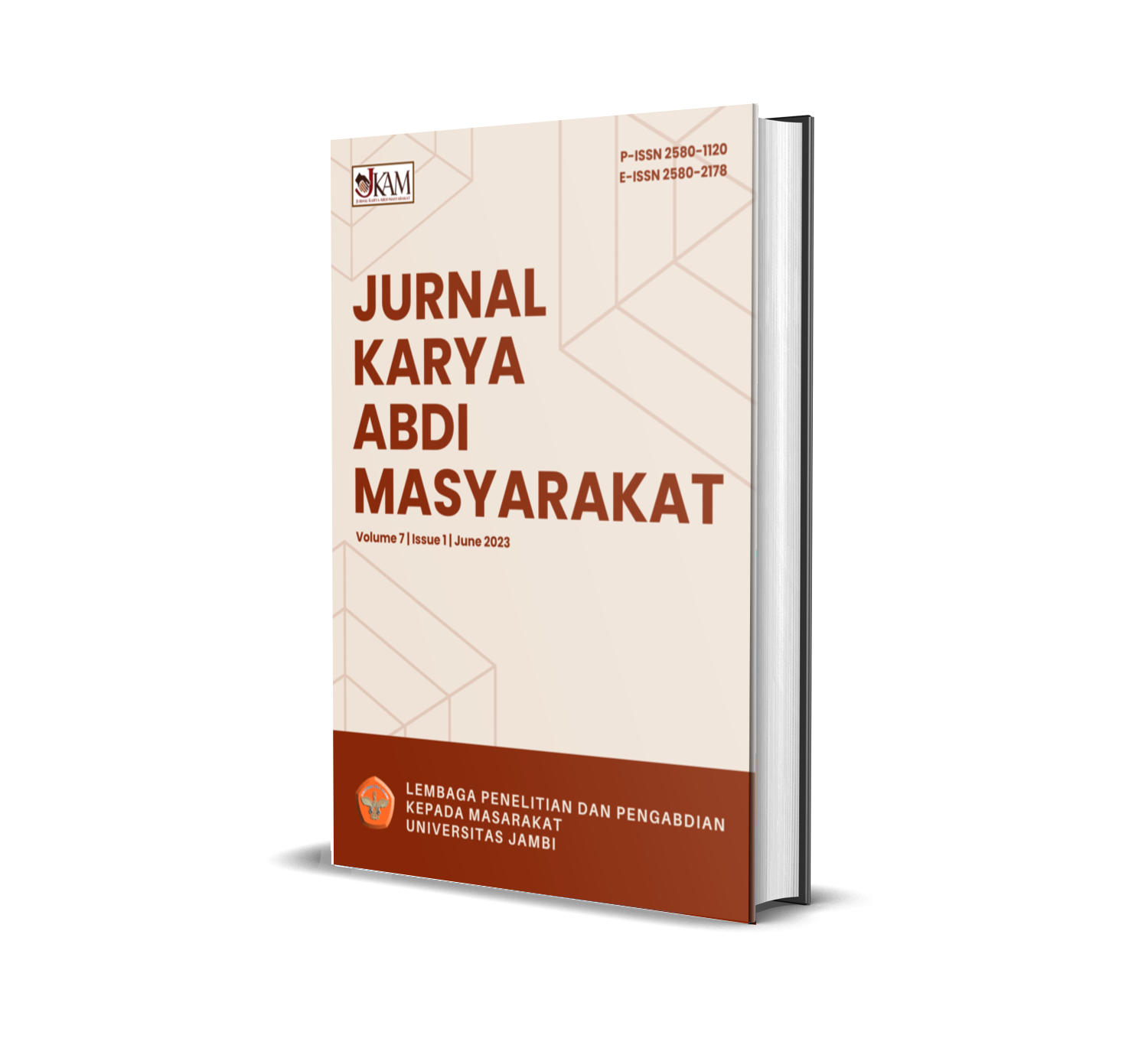Training on Sustainable House Design Based on the Utilization of Natural Lighting in Nyogan Village
DOI:
https://doi.org/10.22437/jkam.v7i1.21162Keywords:
Community Training, Eco-Friendly House, Muaro Jambi, Natural Lighting, Sustainable DevelopmentAbstract
The development of housing has become a government focus, particularly with the introduction of subsidized housing. However, current residential construction often prioritizes financing and aesthetics, neglecting other critical aspects such as environmental conditions and climate factors, including natural lighting and air circulation. Limited public knowledge about these issues contributes to the lack of consideration for natural lighting in home construction. This aspect is vital for creating environmentally friendly homes, as utilizing sunlight can reduce electricity consumption, leading to cost efficiency and environmental sustainability. Therefore, training and outreach are necessary for the community in Nyogan Village, Mestong District, Muaro Jambi Regency, focusing on the use of natural lighting in eco-friendly home design. The existing conditions in Nyogan often result in power outages lasting up to two days, highlighting the need for natural lighting during the day and evening. The training involved local infrastructure officials, carpenters, and community members, providing them with pocket guides on eco-friendly home construction emphasizing natural light utilization. This community service activity has enhanced public knowledge about sustainable housing and increased interest in building environmentally friendly homes.
Downloads
References
Aflaki, A., Mahyuddin, N., Mahmoud, Z. A., &
Baharum, M. R. (2015). A review on
natural ventilation applications through
building
façade components and
ventilation openings in tropical climates.
Energy and Buildings, 101, 153–162.
https://doi.org/10.1016/j.enbuild.2015.
04.033
Amani, A. H. M. (2017). Public perception of
environmentally friendly home buildings
in Banjarmasin City [in Bahasa]. Jurnal
Pendidikan Kewarganegaraan, 7(1), 1–8.
https://doi.org/10.20527/kewarganegar
aan.v7i1.3530
Asnuddin, A. (2012). Control of construction
material remains in residential house
construction. Mektrik, 12(3), 155110.
http://jurnal.untad.ac.id/jurnal/index.ph
p/Mektek/article/download/545/469
Atmando, C. R. (2021). The influence of green
product perception and green brand
image
on
interest
in
buying
environmentally friendly houses among
generation Y in Surabaya. PERFORMA,
4(3),
394–405.
https://doi.org/10.37715/jp.v4i3.1651
Avesta, R., Putri, A. D., Hanifah, R. A., Hidayat,
N. A., & Dunggio, M. D. (2017). Opening
design strategy for natural lighting to
support the energy-efficient building
concept in West Jatinegara flats [in
Bahasa]. Jurnal Rekayasa Hijau, 1(2).
https://doi.org/10.26760/jrh.v1i2.1633
Cadena, J. D. B., Poli, T., Košir, M., Lobaccaro,
G., Mainini, A. G., & Speroni, A. (2022).
Current trajectories and new challenges
for visual comfort assessment in building
design and operation: A critical review.
Cetintahra, G. E., & Cubukcu, E. (2014). The
influence of environmental aesthetics on
economic value of housing: An empirical
research on virtual environments.
Journal of Housing and the Built
Environment,
30(2),
331–340.
https://doi.org/10.1007/s10901-014
9413-6
Dewantoro, F., Budi, W. S., & Prianto, E. (2019).
Study of natural lighting in the reading
room of the university of indonesia
library. Jurnal Arsitektur ARCADE, 3(1),
94.
https://doi.org/10.31848/arcade.v3i1.1
62
Fuerst, F., & Shimizu, C. (2016). Green luxury
goods? The economics of eco-labels in
the Japanese housing market. Journal of
the
Japanese
Economies,
and
39,
International
108–122.
https://doi.org/10.1016/j.jjie.2016.01.0
03
Gago, E., Muneer, T., Knez, M., & Köster, H.
(2014). Natural light controls and guides
in buildings. Energy saving for electrical
lighting, reduction of cooling load.
Renewable and Sustainable Energy
Reviews,
41,
1–13.
https://doi.org/10.1016/j.rser.2014.08.0
02
Geng, Y., Ji, W., Wang, Z., Lin, B., & Zhu, Y.
(2018).
A
review
of
operating
performance in green buildings: Energy
use, indoor environmental quality and
occupant satisfaction. Energy and
Buildings,
183,
500–514.
https://doi.org/10.1016/j.enbuild.2018.
11.017
GhaffarianHoseini, A., Dahlan, N. D., Berardi, U.,
GhaffarianHoseini, A., Makaremi, N., &
GhaffarianHoseini,
M.
(2013).
Sustainable energy performances of
green buildings: A review of current
theories,
implementations
JKAM (Jurnal Karya Abdi Masyarakat) - Vol. 7 (1) 2023 - (39-46)
and
44
Fetty Febriasti Bahar, Hadistya Suryadri, Ira Galih Prabasari, Oki Alfernando
Training on Sustainable House Design Based on the Utilization of Natural Lighting in Nyogan Village
challenges. Renewable and Sustainable
Energy
Reviews,
25,
1–17.
https://doi.org/10.1016/j.rser.2013.01.0
10
Hong, S., Kim, Y., & Yang, E. (2021). Indoor
environment and student productivity
for individual and collaborative work in
learning commons: A case study. Library
Management,
43(1/2),
15–34.
https://doi.org/10.1108/lm-06-2021
0055
Horr, Y. A., Arif, M., Kaushik, A., Mazroei, A.,
Katafygiotou, M., & Elsarrag, E. (2016).
Occupant productivity and office indoor
environment quality: A review of the
literature. Building and Environment,
105,
369–389.
https://doi.org/10.1016/j.buildenv.2016
.06.001
Sustainable Energy Reviews, 39, 277
295.
https://doi.org/10.1016/j.rser.2014.07.0
94
Kwong, Q. J. (2020). Light level, visual comfort
and lighting energy savings potential in a
green-certified high-rise building. Journal
of Building Engineering, 29, 101198.
https://doi.org/10.1016/j.jobe.2020.101
198
Maachi, I. N., Mokhtari, A., & Slimani, M. E.
(2019). The natural lighting for energy
saving and visual comfort in collective
housing: A case study in the Algerian
building context. Journal of Building
Engineering,
24,
100760.
https://doi.org/10.1016/j.jobe.2019.100
760
Jatmiko, A. D., & Setiadarma, E. (2017). The
concept of an environmentally friendly
house facade with solar analysis of the
building to reduce heat radiation into the
room [in Bahasa]. Seminar Nasional Ilmu
Terapan
(SNITER),
1(1).
https://ojs.widyakartika.ac.id/index.php
/sniter/article/download/31/26
Kapferer, J., Klippert, C., & Leproux, L. (2013).
Does luxury have a minimum price? An
exploratory study into consumers’
psychology of luxury prices. Journal of
Revenue and Pricing Management,
13(1),
2–11.
https://doi.org/10.1057/rpm.2013.34
Kaygusuz, K. (2011). Energy for sustainable
development: A case of developing
countries. Renewable and Sustainable
Energy Reviews, 16(2), 1116–1126.
https://doi.org/10.1016/j.rser.2011.11.0
13
Keyvanfar, A., Shafaghat, A., Majid, M. Z. A.,
Lamit, H. B., Hussin, M. W., Ali, K. N. B., &
Saad, A. D. (2014). User satisfaction
adaptive behaviors for assessing energy
efficient building indoor cooling and
lighting environment. Renewable and
Majid, Z. K. (2022). Exterior façade design and
its impact on boosting business and
attracting customers in retail sectors.
Journal of Design Business & Society,
8(1),
69–86.
https://doi.org/10.1386/dbs_00033_1
Maskur, A. (2022). Analysis of estimated costs
for
building
economical
and
environmentally friendly houses for low
income communities [in Bahasa]. Jurnal
Media
Teknologi,
8(2),
75–88.
https://doi.org/10.25157/jmt.v8i2.2665
Mazur, Ł., Bać, A., Vaverková, M. D., Winkler, J.,
Nowysz, A., & Koda, E. (2022). Evaluation
of
the quality of the housing
environment using multi-criteria analysis
that includes energy efficiency: a review.
Energies,
15(20),
7750.
https://doi.org/10.3390/en15207750
Moazzeni, M., & Ghiabaklou, Z. (2016).
Investigating the influence of light shelf
geometry parameters on daylight
performance and visual comfort, a case
study of educational space in Tehran,
Iran.
Buildings,
6(3),
26.
https://doi.org/10.3390/buildings60300
26
JKAM (Jurnal Karya Abdi Masyarakat) - Vol. 7 (1) 2023 - (39-46)
45
Fetty Febriasti Bahar, Hadistya Suryadri, Ira Galih Prabasari, Oki Alfernando
Training on Sustainable House Design Based on the Utilization of Natural Lighting in Nyogan Village
Palarino, C., & Piderit, M. B. (2020).
Optimisation of passive solar design
strategies in side-lit offices: Maximising
daylight penetration while reducing the
risk of glare in different Chilean climate
contexts. Journal of Daylighting, 7(1),
107–121.
https://doi.org/10.15627/jd.2020.9
Romano, R., Aelenei, L., Aelenei, D., &
Mazzucchelli, E. S. (2018). What is an
adaptive façade? Analysis of Recent
Terms and definitions from an
international perspective. DOAJ (DOAJ:
Directory of Open Access Journals).
https://doi.org/10.7480/jfde.2018.3.247
8
Roufechaei, K. M., Bakar, A. H. A., & Tabassi, A.
A. (2013). Energy-efficient design for
sustainable
housing
development.
Journal of Cleaner Production, 65, 380
388.
https://doi.org/10.1016/j.jclepro.2013.0
9.015
Šujanová, P., Rychtáriková, M., Mayor, T. S., &
Hyder, A. (2019). A healthy, energy
efficient
and comfortable indoor
environment, a review. Energies, 12(8),
1414.
https://doi.org/10.3390/en12081414
Tanuwidjaja, G., Mulyono, L. L. A., & Silvanus, D.
C. (2013). Heinz Frick's eco-friendly and
affordable home design [in Bahasa].
.Jurnal
TESA
Arsitektur.
http://repository.petra.ac.id/id/eprint/1
6440
Wibowo, A. P. (2017). Eco-friendly house
criteria. Jurnal Muara Sains Teknologi
Kedokteran Dan Ilmu Kesehatan, 1(1).
https://doi.org/10.24912/jmstkik.v1i1.3
86
Downloads
Published
How to Cite
Issue
Section
License
Copyright (c) 2023 Ermadani, Fetty Febriasti Bahar, Hadistya Suryadri, Ira Galih Prabasari, Oki Alfernando

This work is licensed under a Creative Commons Attribution 4.0 International License.
Please find the rights and licenses in Jurnal Jurnal Karya Abdi Masyarakat (JKAM).
- License
The non-commercial use of the article will be governed by the Creative Commons Attribution license as currently displayed on Creative Commons Attribution 4.0 International License.
- Authors Warranties
The author warrants that the article is original, written by stated author(s), has not been published before, contains no unlawful statements, does not infringe the rights of others, is subject to copyright that is vested exclusively in the author and free of any third party rights, and that any necessary written permissions to quote from other sources have been obtained by the author(s).
- User Rights
JKAM's spirit is to disseminate articles published are as free as possible. Under the Creative Commons license, JKAM permits users to copy, distribute, display, and perform the work for non-commercial purposes only. Users will also need to attribute authors and JKAM on distributing works in the journal.
- Rights of Authors
Authors retain the following rights:
- Copyright, and other proprietary rights relating to the article, such as patent rights,
- The right to use the substance of the article in future own works, including lectures and books,
- The right to reproduce the article for own purposes, provided the copies are not offered for sale,
- The right to self-archive the article.
- Co-Authorship
If the article was jointly prepared by other authors, the signatory of this form warrants that he/she has been authorized by all co-authors to sign this agreement on their behalf, and agrees to inform his/her co-authors of the terms of this agreement.
- Termination
This agreement can be terminated by the author or JKAM upon two months notice where the other party has materially breached this agreement and failed to remedy such breach within a month of being given the terminating party notice requesting such breach to be remedied. No breach or violation of this agreement will cause this agreement or any license granted in it to terminate automatically or affect the definition of JKAM.
- Royalties
This agreement entitles the author to no royalties or other fees. To such extent as legally permissible, the author waives his or her right to collect royalties relative to the article in respect of any use of the article by JKAM or its sublicensee.
- Miscellaneous
JKAM will publish the article (or have it published) in the journal if the articles editorial process is successfully completed and JKAM or its sublicensee has become obligated to have the article published. JKAM may conform the article to a style of punctuation, spelling, capitalization, referencing and usage that it deems appropriate. The author acknowledges that the article may be published so that it will be publicly accessible and such access will be free of charge for the readers.














